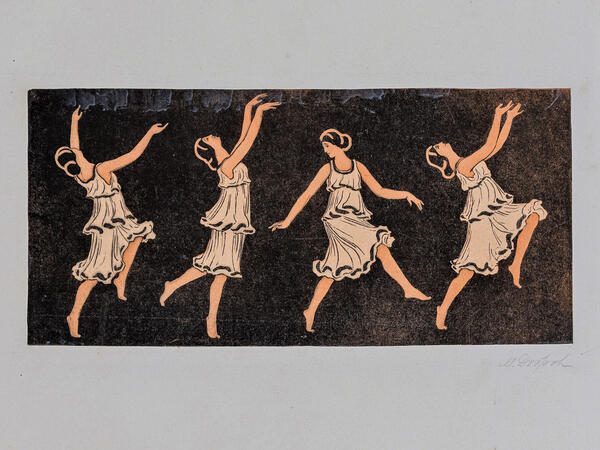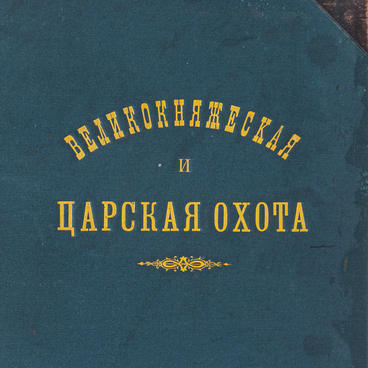Matvei Dobrov, a classic of Russian engraving of the first half of the 20th century, landscape and animal painter and master of etching, was born in 1877 into the family of a doctor. After graduating from gymnasium, he studied at the Department of Physics and Mathematics of the Moscow University.
In 1900, Dobrov left the university to attend the private Art School of Konstantin Yuon and Ivan Dudin. In 1901, he entered the painting department of the Moscow School of Painting, Sculpture and Architecture, where his teachers were Abram Arkhipov, Konstantin Korovin, Valentin Serov, Leonid Pasternak.
In the late 1900s, Dobrov traveled across Europe, studied etching techniques in Paris in the workshop of Russian artist Elizaveta Kruglikova, and drawing at the Colarossi Academy. During this time, he mastered new techniques, for example, color printing, pure etching (drawing on a metal plate with a special needle), aquatint (creating a pattern of tiny indented rings), and learnt to work with soft varnish. Paris etchings greatly influenced the artist’s work. They were bright, slightly stylized and had an aesthetic element to them, which was typical for the Art Nouveau period.
During his ‘Parisian’ period, Dobrov combined his interest in natural sciences with inspiration from ancient culture in his artworks. One of the important themes of his works was the image of the famous dancer Isadora Duncan. She toured Europe, repeatedly came to Russia, directed choreographic productions on revolutionary topics. In 1921-1924, Duncan lived in the USSR. Based on her dances, the artist made several series of etchings that became very popular with the public.
The etching ‘Duncan. Dance’ resembles the ancient red-figure vase painting — one of the most famous techniques of vase painting used by the ancient Greeks. In several depictions of Duncan dancing, the artist conveyed the main features of the ancient art: the cult of the human body and plastic beauty (aesthetic ideal, primarily embodied in the antique sculpture; materialistic beauty).
In the first post-revolutionary years, Dobrov participated in designing decorations for revolutionary holidays in Moscow, propaganda trains (Vladimir Lenin agit-trains), created posters and lubok (prints). Since the late 1910s, the artist developed the theme of the national landscape. In 1919, he created his first etchings from the series ‘Motifs of the Moscow Region’ — he worked on them until the end of his life.
In 1934-1936, Dobrov headed the Ignatius Nivinsky Etching Studio, where he could create large-scale works. At various times, the master taught at the Moscow Graphic Arts College (part of the First Exemplary Typography), at the Drawing Department of Moscow State University and at the Moscow Polygraphic Institute. Dobrov sought to inspire his students with the art of metal engraving, although this technique was not popular as it was too labor-consuming and complex.
In 1900, Dobrov left the university to attend the private Art School of Konstantin Yuon and Ivan Dudin. In 1901, he entered the painting department of the Moscow School of Painting, Sculpture and Architecture, where his teachers were Abram Arkhipov, Konstantin Korovin, Valentin Serov, Leonid Pasternak.
In the late 1900s, Dobrov traveled across Europe, studied etching techniques in Paris in the workshop of Russian artist Elizaveta Kruglikova, and drawing at the Colarossi Academy. During this time, he mastered new techniques, for example, color printing, pure etching (drawing on a metal plate with a special needle), aquatint (creating a pattern of tiny indented rings), and learnt to work with soft varnish. Paris etchings greatly influenced the artist’s work. They were bright, slightly stylized and had an aesthetic element to them, which was typical for the Art Nouveau period.
During his ‘Parisian’ period, Dobrov combined his interest in natural sciences with inspiration from ancient culture in his artworks. One of the important themes of his works was the image of the famous dancer Isadora Duncan. She toured Europe, repeatedly came to Russia, directed choreographic productions on revolutionary topics. In 1921-1924, Duncan lived in the USSR. Based on her dances, the artist made several series of etchings that became very popular with the public.
The etching ‘Duncan. Dance’ resembles the ancient red-figure vase painting — one of the most famous techniques of vase painting used by the ancient Greeks. In several depictions of Duncan dancing, the artist conveyed the main features of the ancient art: the cult of the human body and plastic beauty (aesthetic ideal, primarily embodied in the antique sculpture; materialistic beauty).
In the first post-revolutionary years, Dobrov participated in designing decorations for revolutionary holidays in Moscow, propaganda trains (Vladimir Lenin agit-trains), created posters and lubok (prints). Since the late 1910s, the artist developed the theme of the national landscape. In 1919, he created his first etchings from the series ‘Motifs of the Moscow Region’ — he worked on them until the end of his life.
In 1934-1936, Dobrov headed the Ignatius Nivinsky Etching Studio, where he could create large-scale works. At various times, the master taught at the Moscow Graphic Arts College (part of the First Exemplary Typography), at the Drawing Department of Moscow State University and at the Moscow Polygraphic Institute. Dobrov sought to inspire his students with the art of metal engraving, although this technique was not popular as it was too labor-consuming and complex.



